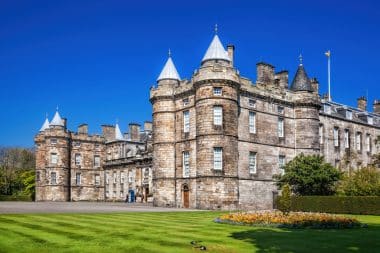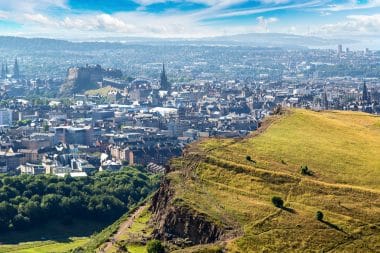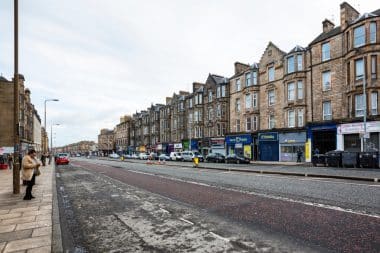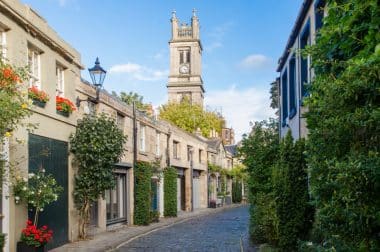Grey stone houses, lush green hills and bright blue sea: Edinburgh, the capital of Scotland since the 15th century, is as charming as it is varied. It is not for nothing that the city has been a UNESCO World Heritage Site since 1995, but also a UNESCO World Heritage Site since 2004. The home of great philosophers and artists attracts visitors with an exciting mix of medieval architecture, modern culture and breathtaking nature.
Inhalt
ToggleEdinburgh Castle

Dùn Èideann, the Scottish Gaelic name of Edinburgh, translates as Edins Castle. Now known as Edinburgh Castle, the eponymous castle in Edinburgh’s Old Town is located at the top of Castle Rock, one of the seven mountains over which the city extends. This is also the oldest part of the capital: evidence of settlements on Castle Rock can be dated back to the Iron Age. Since the 12th century at the latest, a royal castle has stood on this site. Since it no longer serves as a royal residence, Edinburgh Castle is available for visits. A tour takes you through the exciting history of Britain’s most besieged castle and ends with the Scottish Crown Jewels, which are kept here together with the Stone of Scone and are only loaned to London for the coronation of a new monarch. From the forecourt of the castle, there is a stunning view over the Old and New Town, which is still worthwhile after sunset.
Holyrood Palace

Holyrood Palace, officially known as the Palace of Holyroodhouse, served as the official residence of the British monarch in Scotland. Located at the end of the Royal Mile in Edinburgh, it stands opposite Edinburgh Castle and forms the historical counterpart to it. Originally founded as a monastery in the 12th century, the palace has been rebuilt and expanded several times over the centuries. Holyrood Palace is particularly known for its connection to Mary Stuart, Queen of Scots, who lived there from 1561 to 1567.
The palace houses magnificent state apartments, which are an example of the fine European architecture of the 16. and 17th century. Highlights of a tour include the royal chamber where Mary Stuart lived and the ruins of the adjacent Holyrood Abbey. In summer, garden parties are often held in the extensive royal gardens, which are also open for viewing. Holyrood is also known for its art collections, including historical portraits and decorations. Every year, the palace receives thousands of visitors who want to gain insight into the royal history and magnificent architecture.
Arthur’s Seat

Right next to Holyrood Palace is Arthur’s Seat, along with Castle Rock the second of the seven mountains on which Edinburgh was built (Calton Hill, Corstorphine Hill, Craiglockhart Hill, Braid Hill and Blackford Hill make up the other five mountains). Together with the adjacent park, Arthur’s Seat invites you to take long walks. Climb to the top of the mountain, which is relatively easy to reach, and you’ll find yourself about 250 metres above the city and you’ll be rewarded with stunning views over Edinburgh, the surrounding area and the sea. On a clear day, you can even see the Pentland Hills on the horizon. Another worthwhile view at a slightly lower altitude is offered by the Salisbury Craigs. On balmy evenings, you can marvel at how the sun sinks over the city.
Leith Walk

Leith Walk, one of Edinburgh’s longest streets, leads from Waverley Station from the city centre to the hip harbour district of Leith. Colourful restaurants and pubs line the lively street, offering a wonderful opportunity to explore Edinburgh’s lively nightlife. Numerous small shops and cafés entice you to take a walk along “the Walk”, as the street is also colloquially called, during the day.
Princes Street and Dean Village
Princes Street divides Edinburgh into Old Town, the medieval part of Edinburgh, and New Town, the newer, Georgian part. Along the former promenade, there are now numerous opportunities for shopping and refreshments. The Princes Street Gardens also invite you to take a short break in the middle of lush green nature. It’s hard to find peace and quiet from the bustling city: Princes Street Gardens is a popular venue for meetings, concerts and, in winter, Edinburgh’s own Christmas market. However, just a five-minute walk away is the small and quiet oasis of Dean Village. Located directly on the Water of Leith canal, the hustle and bustle of the capital is quickly forgotten here. In the 19th century, there were numerous watermills here, which were fed by the Water of Leith. Today, millstones, fountains and plaques still remind us of them. If you follow the Water of Leith Walkway further towards Leith, you can enjoy the peace and nature in the middle of the city for a few minutes longer.
Stockbridge

If you follow the Water of Leith Walkway in the opposite direction, you will reach the Stockbridge neighbourhood north of the city centre. The home of many musicians, artists and writers attracts with almost village charm. Every Sunday, Saunders Street is also home to Stockbridge Market, where you can buy local and regional art and delicacies – locals also like to do their Sunday shopping here. On any other day, the numerous cafés and small shops offer an equally exciting program. However, strolling through the narrow streets of the neighborhood is the best way to explore its individual and bohemian character.
Insider tip: Arrival
If you arrive from Edinburgh Airport during the day, you should definitely take one of the bus lines to the city. The slightly longer journey takes visitors through the romantic countryside that surrounds Edinburgh and through the charming suburbs that might not have fit into the itinerary on a weekend visit to the city – perfect for getting in the mood or ending an unforgettable holiday in Edinburgh.


